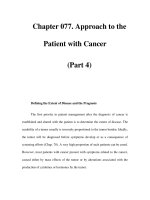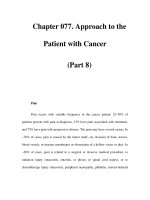approach to the patient with disease of the respiratory system

báo cáo hóa học:" Validation of the Individualised Neuromuscular Quality Of Life for the USA with comparison of the impact of muscle disease on those living in USA versus UK" doc
Ngày tải lên :
20/06/2014, 15:20
... disability. The individual muscle diseases differ in their age of onset, their rate of
progression and their pattern of weakness which in turn dictates the nature and extent of the
disability that they ... and the unknown differences in the type and severity of the epilepsy in the three
national groups.[12]
Other important factors to consider would be the distribution of specific muscle disease ... relationships with other close family
members. I require more from them.” – US patient.
Problems of access to the homes of friends and family and to social venues were also a
source of difficulty...
- 38
- 391
- 0


Care of the Patient with Retinal Detachment And Related Peripheral Vitreoretinal Disease docx
Ngày tải lên :
22/03/2014, 09:20
... and other devices geared to improve the
patient& apos;s quality of life and ability to function in their own households.
The optometrist should provide the patient written documentation of his ...
affecting the venules; it is seen as sheathed, attenuated retinal vessels.
Progression of pars planitis can lead to continued obliteration of the
vessels toward the posterior pole, together with the ... Followup
The prognosis for the patient with a retinal break and the need for
followup by the optometrist depend on the type and severity of the break.
The frequency and composition of evaluation...
- 41
- 351
- 0
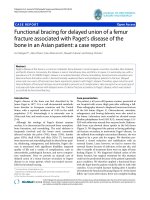
báo cáo hóa học:" Functional bracing for delayed union of a femur fracture associated with Paget''''s disease of the bone in an Asian patient: a case report" pot
Ngày tải lên :
20/06/2014, 04:20
... not be performed because of the patient& apos;s generally
poor condition. We therefore applied a functional brace
with the hope that the patient would be able to walk with
crutches. X-ray revealed ... plate osteosynthesis (MIPO) techniques mini-
mize the extent of soft tissue trauma to the injury zone,
theoretically maintaining a better blood supply around
the fracture area. Treatment of fractures ... predispose patients to fracture. Delayed
union and non-union of fractures have been reported in patients with Paget's disease. Therefore, open reduction and
internal fixation of fractures...
- 4
- 402
- 0

Chapter 052. Approach to the Patient with a Skin Disorder (Part 1) ppt
Ngày tải lên :
06/07/2014, 20:20
... 052. Approach to the Patient
with a Skin Disorder
(Part 1)
Harrison's Internal Medicine > Chapter 52. Approach to the Patient with
a Skin Disorder
APPROACH TO THE PATIENT WITH ... Fig. 52-3) and to
formulate a differential diagnosis (Table 52-4). For instance, the finding of scaling
papules (present in patients with psoriasis or atopic dermatitis) places the patient
in ... that the erosion is the primary lesion and the redness and scale
are secondary, while the correct interpretation would be that the patient has a
pruritic eczematous dermatitis with erosions caused...
- 5
- 413
- 0

Chapter 052. Approach to the Patient with a Skin Disorder (Part 2) potx
Ngày tải lên :
06/07/2014, 20:20
... of skin lesions formed from coalescing rings or
incomplete rings.
Pruritus: A sensation that elicits the desire to scratch. Pruritus is often the
predominant symptom of inflammatory skin diseases ... thyroid disease, polycythemia
vera, and delusions of parasitosis.
Figure 52-3
Erosion: Loss of epidermis without an associated loss of dermis.
Ulcer: Loss of epidermis and at least a portion of ...
Table 52-3 Common Dermatologic Terms
A schematic representation of several common primary skin lesions
(see Table 52-1).
Chapter 052. Approach to the Patient
with a Skin Disorder
(Part...
- 5
- 334
- 0

Chapter 052. Approach to the Patient with a Skin Disorder (Part 4) doc
Ngày tải lên :
06/07/2014, 20:20
... lesions often correlates highly with diagnosis (Fig. 52-6).
For example, a hospitalized patient with a generalized erythematous exanthem is
more likely to have a drug eruption than is a patient with ... a patient with a similar rash limited to
the sun-exposed portions of the face. Once the distribution of the lesions has been
established, the nature of the primary lesion must be determined. ... lesions, the shape of individual lesions, and the arrangement of the
lesions.
An ideal skin examination includes evaluation of the skin, hair, and nails as
well as the mucous membranes of the mouth,...
- 5
- 414
- 0
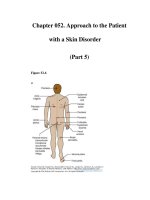
Chapter 052. Approach to the Patient with a Skin Disorder (Part 5) pptx
Ngày tải lên :
06/07/2014, 20:20
... papulosquamous skin disease is characterized by small and
large erythematous papules and plaques with overlying adherent silvery scale.
Figure 52-8
Chapter 052. Approach to the Patient
with a Skin...
- 5
- 321
- 0
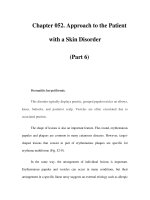
Chapter 052. Approach to the Patient with a Skin Disorder (Part 6) pdf
Ngày tải lên :
06/07/2014, 20:20
... lesions with a
generalized arrangement are common and suggest a systemic etiology.
Figure 52-9
Erythema multiforme.
This eruption is characterized by multiple erythematous plaques with ... represents a hypersensitivity reaction to drugs
(e.g., sulfonylamides) or infections (e.g., HSV). (Courtesy of the Yale Resident's
Slide Collection; with permission.)
Figure 52-10
...
- 5
- 319
- 0

Chapter 052. Approach to the Patient with a Skin Disorder (Part 7) ppt
Ngày tải lên :
06/07/2014, 20:20
... against the surface of the
skin and rotated with downward pressure until it penetrates to the subcutaneous
tissue. The circular biopsy is then lifted with forceps, and the bottom is cut with
iris ... previous illnesses
6. History of allergies
7. Presence of photosensitivity
8. Review of systems
9. Family history (particularly relevant for patients with melanoma,
atopy, psoriasis, or acne) ... suspected. The edge of such a lesion is scraped
gently with a no. 15 scalpel blade, and the removed scale is collected on a glass
microscope slide then treated with 1 to 2 drops of a solution of 10–20%...
- 5
- 398
- 0
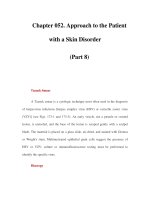
Chapter 052. Approach to the Patient with a Skin Disorder (Part 8) pptx
Ngày tải lên :
06/07/2014, 20:20
... may also aid in the demonstration of tinea versicolor and
in recognition of ash leaf spots in patients with tuberous sclerosis.
Figure 52-12
Diascopy is designed to assess whether a skin lesion ...
noting the amount of blanching that occurs. Granulomas often have an opaque to
transparent, brown-pink "apple jelly" appearance on diascopy.
Figure 52-11
Chapter 052. Approach to the ... or crusted
lesion, is unroofed, and the base of the lesion is scraped gently with a scalpel
blade. The material is placed on a glass slide, air-dried, and stained with Giemsa
or Wright's...
- 5
- 367
- 0
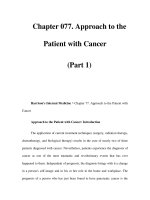
Chapter 077. Approach to the Patient with Cancer (Part 1) potx
Ngày tải lên :
07/07/2014, 01:20
... Approach to the
Patient with Cancer
(Part 1)
Harrison's Internal Medicine > Chapter 77. Approach to the Patient with
Cancer
Approach to the Patient with Cancer: Introduction
The ... of current treatment techniques (surgery, radiation therapy,
chemotherapy, and biological therapy) results in the cure of nearly two of three
patients diagnosed with cancer. Nevertheless, patients ... cancer patients.
The 5-year survival for white patients was 39% in 1960–1963 and 68% in 1996–
same as the prognosis of the person with aortic stenosis who develops the first
symptoms of congestive...
- 8
- 275
- 0
Tìm thêm:
- hệ việt nam nhật bản và sức hấp dẫn của tiếng nhật tại việt nam
- xác định các mục tiêu của chương trình
- xác định các nguyên tắc biên soạn
- khảo sát các chuẩn giảng dạy tiếng nhật từ góc độ lí thuyết và thực tiễn
- khảo sát chương trình đào tạo của các đơn vị đào tạo tại nhật bản
- khảo sát chương trình đào tạo gắn với các giáo trình cụ thể
- xác định thời lượng học về mặt lí thuyết và thực tế
- tiến hành xây dựng chương trình đào tạo dành cho đối tượng không chuyên ngữ tại việt nam
- điều tra đối với đối tượng giảng viên và đối tượng quản lí
- điều tra với đối tượng sinh viên học tiếng nhật không chuyên ngữ1
- khảo sát thực tế giảng dạy tiếng nhật không chuyên ngữ tại việt nam
- khảo sát các chương trình đào tạo theo những bộ giáo trình tiêu biểu
- nội dung cụ thể cho từng kĩ năng ở từng cấp độ
- xác định mức độ đáp ứng về văn hoá và chuyên môn trong ct
- phát huy những thành tựu công nghệ mới nhất được áp dụng vào công tác dạy và học ngoại ngữ
- mở máy động cơ lồng sóc
- mở máy động cơ rôto dây quấn
- các đặc tính của động cơ điện không đồng bộ
- hệ số công suất cosp fi p2
- đặc tuyến hiệu suất h fi p2

